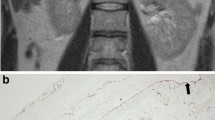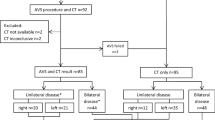Abstract
We aimed to confirm whether postmortem adrenal volumetric changes occur by measuring adrenal volumes on computed tomography (CT). Fifty-five adrenal glands from 28 subjects who died were included. All subjects underwent antemortem CT (AMCT) and postmortem CT (PMCT) within 94–1,191 min after death, followed by conventional autopsy. CT volumetry was performed using freely-available software. Differences between AMCT and PMCT adrenal volumes were evaluated statistically along with differences in the degree of volume change, elapsed time to PMCT, and presence of underlying malignant disease. The mean volume of the right adrenal gland decreased from 3.8 cm3 on AMCT to 2.6 cm3 on PMCT (P < 0.001); the left adrenal gland decreased from 4.2 cm3 on AMCT to 3.1 cm3 on PMCT (P < 0.001). Conventional autopsy revealed decreased intracellular lipid components in portions of the adrenal glands. No correlation between the adrenal gland reduction rate and the elapsed time from AMCT to death or from death to PMCT was observed (P = 0.99 and 0.79; P = 0.28 and 0.59 for the right and left adrenal glands, respectively). Significant differences in both the bilateral adrenal gland reduction rates and underlying malignant disease were found for the left adrenal gland (P = 0.015), but not for the right (P = 0.74). Adrenal volume reduction was observed on PMCT compared to AMCT. This highlights the need to further elucidate the mechanism of adrenal shrinkage during the agonal stage and after death. This may be explained by pathological findings of intracellular lipid depletion.


Similar content being viewed by others
References
Patriquin L, Kassarjian A, Barish M et al (2001) Postmortem whole-body magnetic resonance imaging as an adjunct to autopsy: preliminary clinical experience. J Magn Reson Imaging 13:277–287
Thali MJ, Yen K, Schweitzer W et al (2003) Virtopsy, a new imaging horizon in forensic pathology: virtual autopsy by postmortem multislice computed tomography (MSCT) and magnetic resonance imaging (MRI)—a feasibility study. J Forensic Sci 48:386–403
Ezawa H, Yoneyama R, Kandatsu S et al (2003) Introduction of autopsy imaging redefines the concept of autopsy: 37 cases of clinical experience. Pathol Int 53:865–873
Egger C, Bize P, Vaucher P et al (2012) Distribution of artifactual gas on post-mortem multidetector computed tomography (MDCT). Int J Legal Med 126:3–12
Yang KM, Lynch M, O’Donnell C (2011) “Buckle” rib fracture: an artifact following cardio-pulmonary resuscitation detected on postmortem CT. Leg Med (Tokyo) 13:233–239
Shiotani S, Kohno M, Ohashi N, Yamazaki K, Nakayama H, Watanabe K et al (2004) Non-traumatic postmortem computed tomographic (PMCT) findings of the lung. Forensic Sci Int 139:39–48
Ishida M, Gonoi W, Hagiwara K et al (2011) Intravascular gas distribution in the upper abdomen of non-traumatic in-hospital death cases on postmortem computed tomography. Leg Med (Tokyo) 13:174–179
Ishida M, Gonoi W, Hagiwara K et al (2011) Hypostasis in the heart and great vessels of non-traumatic in-hospital death cases on postmortem computed tomography: relationship to antemortem blood tests. Leg Med (Tokyo) 13:280–285
Okuma H, Gonoi W, Ishida M et al (2013) Heart wall is thicker on postmortem computed tomography than on antemortem computed tomography: the first longitudinal study. PLoS One 8(9):e76026
Hyodoh H, Sato T, Onodera M et al (2012) Vascular measurement changes observed using postmortem computed tomography. Jpn J Radiol 30:840–845
Takahashi N, Higuchi T, Hirose Y et al (2013) Changes in aortic shape and diameters after death: comparison of early postmortem computed tomography with antemortem computed tomography. Forensic Sci Int 225:27–31
Takahashi N, Satou C, Higuchi T et al (2010) Quantitative analysis of intracranial hypostasis: comparison of early postmortem and antemortem CT findings. Am J Roentgenol 195:W388–W393
Ishida M, Gonoi W, Hagiwara K et al (2011) Postmortem changes of the thyroid on computed tomography. Leg Med (Tokyo) 13:318–322
Levy AD, Harcke HT, Mallak CT (2010) Postmortem imaging: MDCT features of postmortem change and decomposition. Am J Forensic Med Pathol 31:12–17
Bernard K (1997) Simpson’s forensic medicine, 11th edn. Arnold, London
Prionas ND, Gillen MA, Boone JM (2010) Longitudinal volume analysis from computed tomography: reproducibility using adrenal glands as surrogate tumors. J Med Phys 35:174–180
Gonoi W, Akahane M, Watanabe Y et al (2013) Visualization of bile movement using MRI spin-labeling technique: preliminary results. Am J Roentgenol 201:133–141
Geraghty EM, Boone JM, McGahan JP, Jain K (2004) Normal organ volume assessment from abdominal CT. Abdom Imaging 29:482–490
Wang X, Jin ZY, Xue HD et al (2013) Evaluation of normal adrenal gland volume by 64-slice CT. Chin Med Sci J 27:220–224
Sawabe M, Saito M, Naka M et al (2006) Standard organ weights among elderly Japanese who died in the hospital, including 50 centenarians. Pathol Int 56:315–323
Lam KY, Chan AC, Lo CY (2001) Morphological analysis of adrenal glands: a prospective analysis. Endocr Pathol 12:33–38
Kurtulus A, Acar K, Sorkun H et al (2012) The relationship between adrenal gland morphometric changes and postmortem interval in rats: a stereological study. Leg Med (Tokyo) 14:214–218
Reinhard BD (2012) Forensic histopathology: fundamentals and perspectives, 1st edn. Springer, Berlin
Alejandro VS, Strafuss AC (1984) Microscopic postmortem changes in adrenal glands of the domestic fowl. Avian Dis 28:374–385
Kumar V, Abbas AK, Fausto N (2004) Robbins and Cotran pathologic basis of disease, 7th edn. Saunders, New Delhi
Di Maio VJ, Di Maio DJ (2001) Forensic pathology, 2nd edn. CRC Press, Boca Raton
Acknowledgment
This work was supported in part by a grant from the Japanese Ministry of Health, Labor and Welfare, for research into "Usefulness of postmortem images as an ancillary method for autopsy in evaluation of death associated with medical practice (2008–2009).
Conflict of interest
The authors declare no conflict of interest.
Author information
Authors and Affiliations
Corresponding author
Rights and permissions
About this article
Cite this article
Ishida, M., Gonoi, W., Hagiwara, K. et al. Early postmortem volume reduction of adrenal gland: initial longitudinal computed tomographic study. Radiol med 120, 662–669 (2015). https://doi.org/10.1007/s11547-014-0449-1
Received:
Accepted:
Published:
Issue Date:
DOI: https://doi.org/10.1007/s11547-014-0449-1




